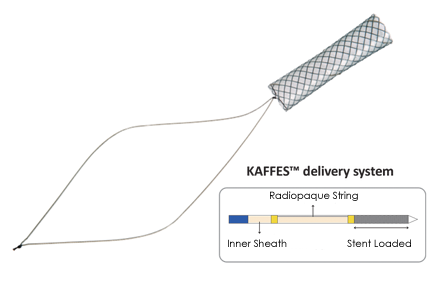Kaffes™ Stent
| Category: Interventional Biliary Stents |
To treat anastomic strictures after liver transplantation
Indication:
Anastomic strictures after liver transplantation
Details / Features
- Characteristic waist at mid-portion of the stent: Waist shape of the stent allows strong radial force and preventing migration
- Short length of stent: Using a short stent across the stricture prevents to impart pressure over a large area of normal duct by reducing the potential risk of necrosis and fibrosis
- Long platinum radio-paqued retrieval string: The long platinum string helps easy removal from the high up location of CBD
- Covered part can prevent bile leak through transluminal track between stomach and left hepatic duct.
- Uncovered part can prevent migration and cholangitis without obstructing side branches of hepatic ducts.
- Flared end is located out of the stomach wall preventing migration into hepatic duct
Radiopaque Markers: Three (3) at both ends and two (2) in the middle
Key Resources
Clinical Reference
- A randomized trial of a fully covered self-expandable metallic stent versus plastic stents in anastomotic biliary strictures after liver transplantation
by Arthur Kaffes et al [Therap Adv Gastroenterol. 2014 Mar;7(2):64-71]
- Fully covered self-expandable metal stents for treatment of benign biliary strictures
by Arthur Kaffes et al [Gastrointest Endosc. 2013 July;78(1):13-21]
- Placement of removable metal biliary stent in post-orthotopic liver transplantation anastomotic stricture
by Hoi-Poh Tee et al [World J Gastroenterol. 2010 Jul 28;16(28):3597-600]

